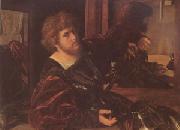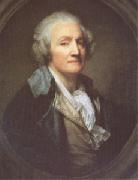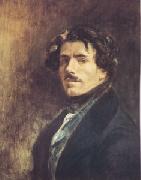Wholesale Oil Painting No Minimum |
|||||||||||
|
|
|||||||||||

|
|||||||||||
|
|
|
||||||||
SAVOLDO, Giovanni GirolamoItalian Mannerist Painter, ca.1480-1548 |
||||||||
|
|
||||||||
Portrait of the Artist (mk05)
Portrait of the Artist (mk05) Painting ID:: 20307 |
Canvas,36 x 48 1/2''(91 x 123 cm)Collection of Francois Canvas,36 x 48 1/2''(91 x 123 cm)Collection of Francois |
|||||||
|
|
||||||||
Jean Baptiste Greuze1725-1805 French Jean Baptiste Greuze Galleries French painter and draughtsman. He was named an associate member of the Academie Royale de Peinture et de Sculpture, Paris, in 1755 on the strength of a group of paintings that included genre scenes, portraits and studies of expressive heads (t?tes d'expression). These remained the essential subjects of his art for the next 50 years, except for a brief, concentrated and unsuccessful experiment with history painting in the late 1760s, which was to affect his later genre painting deeply. Though his art has often been compared with that of Jean-Simeon Chardin in particular and interpreted within the context of NEO-CLASSICISM in general, it stands so strikingly apart from the currents of its time that Greuze's accomplishments are best described, as they often were by the artist's contemporaries, as unique. He was greatly admired by connoisseurs, critics and the general public throughout most of his life. His pictures were in the collections of such noted connoisseurs as Ange-Laurent de La Live de Jully, Claude-Henri Watelet and Etienne-Francois, Duc de Choiseul. For a long period he was in particular favour with the critic Denis Diderot, who wrote about him in the Salon reviews that he published in Melchior Grimm's privately circulated Correspondance litteraire. His reputation declined towards the end of his life and through the early part of the 19th century, to be revived after 1850, when 18th-century painting returned to favour, by such critics as Th?ophile Thore, Arsene Houssaye and, most notably, Edmond and Jules de Goncourt in their book L'Art du dix-huiti?me siecle. By the end of the century Greuze's work, especially his many variations on the Head of a Girl, fetched record prices, and his Broken Pitcher (Paris, Louvre) was one of the most popular paintings in the Louvre. The advent of modernism in the early decades of the 20th century totally obliterated Greuze's reputation. It was only in the 1970s, with Brookner's monograph, Munhall's first comprehensive exhibition of the artist's work, increased sale prices, important museum acquisitions and fresh analyses of his art by young historians, that Greuze began to regain the important place that he merits in the history of French art of the 18th century. |
||||||||
|
|
||||||||
|
|
Portrait of the Artist (mk05)
Portrait of the Artist (mk05) Painting ID:: 20750 |
Wood 25 1/2 x 20 1/2''(65 x 52 cm)Bequest of Dr Louis La Caze 1869 Wood 25 1/2 x 20 1/2''(65 x 52 cm)Bequest of Dr Louis La Caze 1869 |
||||||
|
|
||||||||
Jacques-Louis DavidFrench b.Aug. 30, 1748, Paris d.Dec. 29, 1825, Brussels Jacques-Louis David is famous for his huge, dramatic canvasses of Napoleon and other historical figures, including Oath of the Horatii (1784), Death of Marat (1793) and The Sabine Women (1799). Early in his career he was a leader in the neoclassical movement; later his subjects became more modern and political. David was himself active in the French Revolution as a supporter of Robespierre and is sometimes called the chief propagandist for the Revolution; after the Reign of Terror ended he was briefly imprisoned for his actions. When Napoleon took power David became his court painter and created several grand canvasses of the Emperor, including the heroic Napoleon Bonaparte Crossing the Alps (1801) and the enormous Coronation of Napoleon and Josephine (1807). David also painted Napoleon in His Study (1812), with its famous image of Napoleon with one hand tucked inside his vest. After Napoleon ouster David went in exile to Brussels, where he remained until his 1825 death |
||||||||
|
|
||||||||
|
|
Portrait of the Artist (mk05)
Portrait of the Artist (mk05) Painting ID:: 20790 |
1794
Canvas 32 x 25 1/4''(81 x 64 cm)Given by Eugene Isbey in 1852 INV 1794 Canvas 32 x 25 1/4''(81 x 64 cm)Given by Eugene Isbey in 1852 INV |
||||||
|
|
||||||||
Jean Baptiste Camille Corot1796-1875 Corot Locations French painter, draughtsman and printmaker. After a classical education at the College de Rouen, where he did not distinguish himself, and an unsuccessful apprenticeship with two drapers, Corot was allowed to devote himself to painting at the age of 26. He was given some money that had been intended for his sister, who had died in 1821, and this, together with what we must assume was his family continued generosity, freed him from financial worries and from having to sell his paintings to earn a living. Corot chose to follow a modified academic course of training. He did not enrol in the Ecole des Beaux-Arts but studied instead with Achille Etna Michallon and, after Michallon death in 1822, with Jean-Victor Bertin. Both had been pupils of Pierre-Henri Valenciennes, and, although in later years Corot denied that he had learnt anything of value from his teachers, his career as a whole shows his attachment to the principles of historic landscape painting which they professed. |
||||||||
|
|
||||||||
|
|
Portrait of the artist (mk05)
Portrait of the artist (mk05) Painting ID:: 20886 |
1825
Paper on canvas 13 x 10''(33 x 25 cm)Given in 1906 R.F 1608(G/AR) 1825 Paper on canvas 13 x 10''(33 x 25 cm)Given in 1906 R.F 1608(G/AR) |
||||||
|
|
||||||||
Eugene DelacroixFrench Romantic Painter, 1798-1863 For 40 years Eugene Delacroix was one of the most prominent and controversial painters in France. Although the intense emotional expressiveness of his work placed the artist squarely in the midst of the general romantic outpouring of European art, he always remained an individual phenomenon and did not create a school. As a personality and as a painter, he was admired by the impressionists, postimpressionists, and symbolists who came after him. Born on April 28, 1798, at Charenton-Saint-Maurice, the son of an important public official, Delacroix grew up in comfortable upper-middle-class circumstances in spite of the troubled times. He received a good classical education at the Lycee Imperial. He entered the studio of Pierre Narcisse Guerin in 1815, where he met Theodore Gericaul |
||||||||
|
|
||||||||
|
|
Portrait of the Artist (mk05)
Portrait of the Artist (mk05) Painting ID:: 20916 |
Canvas 25 1/2 x 21 1/2''(65 x 55 cm)Bequeathed by Delacroix to Jenny Le Guillou,his housekeeper,on the condition of giving it to the Louvre after the return to power of the Orleans family;sent to the Louvre by the painter Andrieu in 1872 R.F 25 (G/AR) Canvas 25 1/2 x 21 1/2''(65 x 55 cm)Bequeathed by Delacroix to Jenny Le Guillou,his housekeeper,on the condition of giving it to the Louvre after the return to power of the Orleans family;sent to the Louvre by the painter Andrieu in 1872 R.F 25 (G/AR) |
||||||
|
|
||||||||
|
Eugene Delacroix French Romantic Painter, 1798-1863 For 40 years Eugene Delacroix was one of the most prominent and controversial painters in France. Although the intense emotional expressiveness of his work placed the artist squarely in the midst of the general romantic outpouring of European art, he always remained an individual phenomenon and did not create a school. As a personality and as a painter, he was admired by the impressionists, postimpressionists, and symbolists who came after him. Born on April 28, 1798, at Charenton-Saint-Maurice, the son of an important public official, Delacroix grew up in comfortable upper-middle-class circumstances in spite of the troubled times. He received a good classical education at the Lycee Imperial. He entered the studio of Pierre Narcisse Guerin in 1815, where he met Theodore Gericaul Portrait of the Artist (mk05) Canvas 25 1/2 x 21 1/2''(65 x 55 cm)Bequeathed by Delacroix to Jenny Le Guillou,his housekeeper,on the condition of giving it to the Louvre after the return to power of the Orleans family;sent to the Louvre by the painter Andrieu in 1872 R.F 25 (G/AR) |
||||||||
|
|
||||||||
|
Prev Next
|
||||||||
|
|
||||||||
|
Related Paintings to Eugene Delacroix :. |
||||||||
|
|
||||||||
|
CONTACT US |





